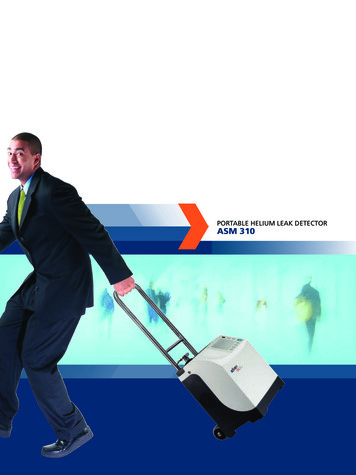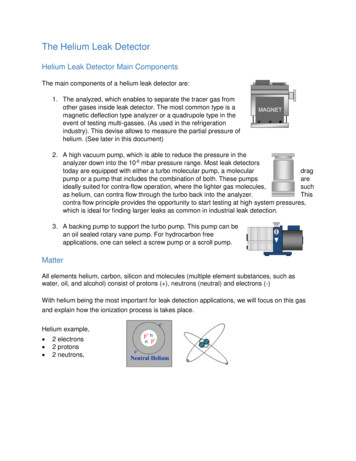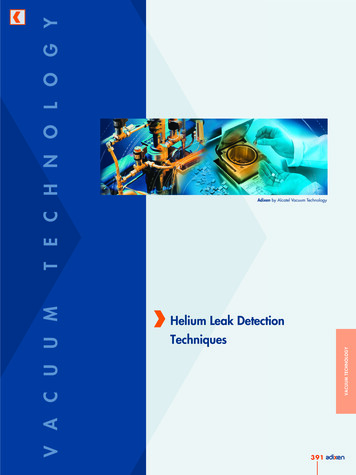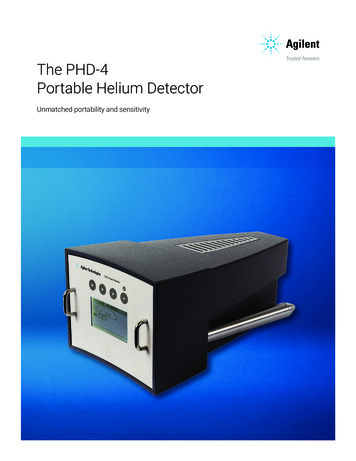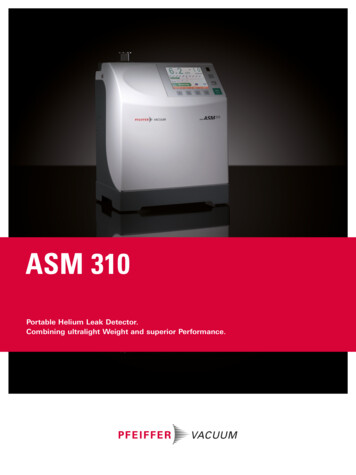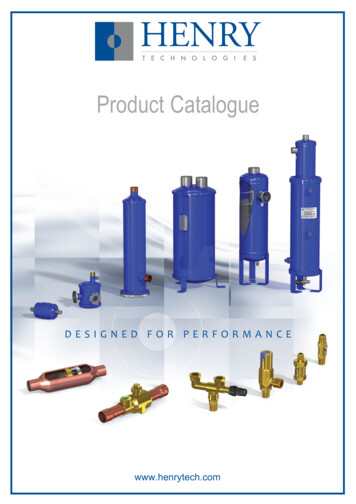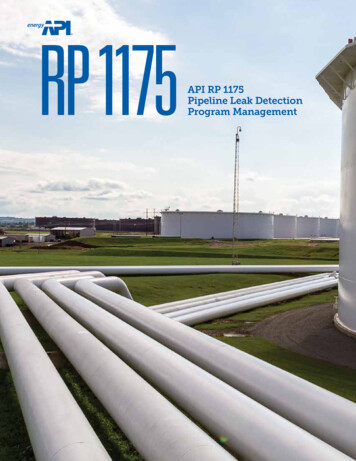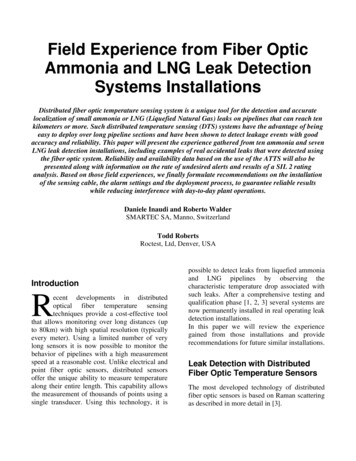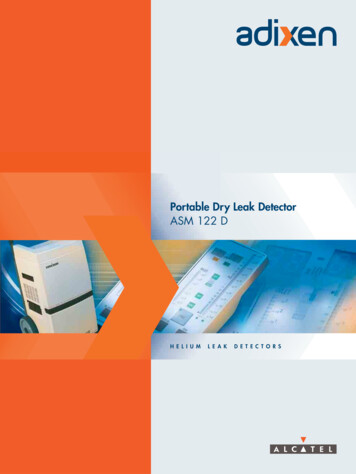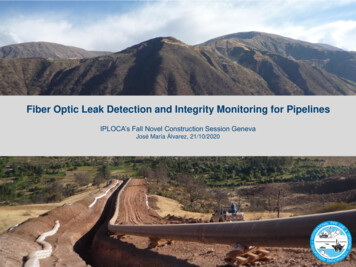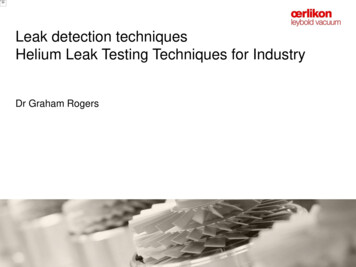
Transcription
Leak detection techniquesHelium Leak Testing Techniques for IndustryDr Graham Rogers
Leak detection techniquesReasons for Leak Testing Environmental Safety ISO 9000 Product life Reliability Product specifications Marketing advantage
Leak detection techniquesApplication listAnalyticalMedicine technologyIT Mass spectrometersystems Electron beammicroscopes Transfer chambers Load looks TubingAutomotivePower engineeringVacuum equipment Power turbine Power condenser High voltage components Whole vacuum program Pump housingsR&DProcess industry Furnaces Soldering ovens High pressure valvesACBrake tubingHeat exchangerFuel erElectron microscopeX-ray tubesAmpullaHe bath cooler3He coolerLon beam acceleratorsUHV /XHV systemsHe transfer lines
Leak detection techniquesTypes of LeaksLeaks at connections Flanges, welding, soldering, grindings(glass fittings)Permeation leaks Gas transport through materials e.g.elastomeric seals, glassPorosity leaks CastingsVirtual leaks Gaps, small volumes in castings,evaporation of liquids, sintered metal,plastic partsHot /cold leaks Cracks open or close due to thermaltensions
Leak detection techniquesDefinition of mbarl/sIn a volume of 1 liter the pressure risesfrom 1mbar within 1 second to 2 mbar,that is a leak rate ofΔpQ .VΔtQ Troughput1mbar . I . s 1V Volume p pressure differencerise pressure mbar t time differenceVolume of 1 litertime /s
Leak detection techniquesExamples of well known leaksWater tap 1 drip per second1,7x10-1 mbarl/sHair between O-ring and flange1x10-3 - 5x10-2 mbarl/sBicycle tube in water (bubble test, 1 bubble/sec)1x10-2 mbarl/sCar wheel loses air 1,8 1,6 bar in 6 month4x10-5 mbarl/s
Leak detection techniquesMethods of Leak TestsProcedureMediumLimit of leakrate mbarl/sPressurerangeRise pressureAir & others10-4 VacuumLimitedPressure dropAir & others10-4 OverpressureLimitedFoaming agentAir & others10-5 OverpressureNoBubble testAir & others10-4 OverpressureLimitedSupersonicAir & others10-2 Overpressure/Low pressureNoThermal conductivityAir & others10-5 Overpressure/Low pressureNoMass spectrometerquadruppoleRefrigerents;gases10-7 OverpressureYesMass spectrometermagnet sector fieldHeliumHydrogen 10-7 OverpressureYesMass spectrometermagnet sector fieldHeliumHydrogen 5 x 10-12 VacuumQuantifiableYes
Leak detection techniquesPressure rise effects in a chambera) Leakb) Desorbtionc) Leak Desorbtion
Leak detection techniquesPressure rise method with vacuum ( no Helium )Example:Test volume: V 1m³ p: p 1 · 10-3 mbar until 8 · 10-3 mbarTime : t 5 minQL ?vQ . p[mbar · I · s 1 ]t 1000 I7 · 10 3 mbar300SAir leak rate 2,33.10 2 mbar.I .s 1 p p2 p1 8.10 3 1.10 3 7.10 3 mbar
Leak detection techniquesWhy is Helium a good Test Gas? Low concentration in air , only 5 ppm, so low natural background Inert gas, non toxic, non- explosive, environmentally friendly Good separation in a mass spectrometer (no cross sensitivity to other gases andno mass fragments Lighter than air Very small gas molecule, can easily pass through small holes/gaps
Leak detection techniquesPrinciple Methods of Leak DetectionVacuum method Global detection ( He outside ) Global detection ( He inside ) Local detectionOverpressure method Local detection ( sniffing )
Leak detection techniquesVacuum MethodGlobalDetectionLowest detectable leak rate 5x10-12 mbarl/s1 Pressure chamber w Helium2 Test vessel13 Leak detectorTest unitHelium(under vacuum)254 Helium5 Auxiliary Pump System43
Leak detection techniquesVacuum MethodGlobalDetectionLowest detectable leak rate 5x10-12 mbarl/s1 Vacuum chamber2 Test body3 Leak detector14 Helium25 Auxiliary Pump System for huge vessels543
Leak detection techniquesVacuum MethodLocalDetectionLowest detectable leak rate 5x10-12 mbarl/s1 Spray gun2 Test body3 Leak detector214 Helium5 Auxiliary Pump System (for large vessels)543
Leak detection techniquesOverpressure MethodLocalDetection(sniffing)Lowest detectable leak rate 1x10-7 mbarl/s!!!1 Sniffer probe2 Test vessel3 Leak detector14 Helium234
Leak detection techniquesPartial Flow System
Leak detection techniquesPartial Flow System
Leak detection techniquesConversion of mass flowes – (Leak Rates)1 kg·h-1(0 C)Cm3/h(NTP)Cm3/s(NTP)Torr. l/sg/a(F12.20 C)g/a(F12.25 (20 313.86Kg.h-1 (0 c)2180.93217.74.105215163--34.6.1041.63 · 10521.8 · 10312.912.81 · 10-41.20 · 10-61.29 · 10-612.78 · 10-2.11 · 10-444-44.7 · 10-22.11 · 10-12.81 · 10-21.66 · 52.05.10521191.10313378.8.10-3g/a(F12.20 34.8.10-36.39.10-437.9.10-8g/a(F12.25 -438.5.10-8m.cfm6.28.10-42.69.10-62.89 . 12.7.10316.9.1021mbar.I/sCm3/h(NTP)cm3/s (NTP)Torr.1/s kg·h-1(20 C)mbar · l/scm3 (NTP) 1cm3 under41normal condition (T 273.15K; P 1013.25 mbar)NTP Normal temperature and pressure (1atm; 0 C) R 83.14 mbar.1.mol-1. K-11cm3 (NTP) h-1 1 atm. cm3. h-1 Ncm3. h-1 1 std cch1sccm 10-3 slpm 10-3 N.I.min-1 60sccsSI-System kohärent: 1 pa.m3. s-1 10 mbar.1.s-1; R 8.314 pa.m3.mol-1.K-1 ;M in kg / mol1 cm3 (NTP) . s-1 1 sccs 60cm3 (NTP). Min-1 60 SCCM 60 Std ccm 60 Ncm 3. min-11 lusec 1 l.μ.s.-1 1.μ 1 micron 10-3 Torr 1 lusec 10-3 Torr.I.s-1Freon F 12 (CC12FC) M 120.92 g.mol-1; Luft M 28.96g. Mol-1Achtung: Anglo-amerikanische Einheiten werden uneinheitlich abgekürzt! Beispiel: Standard cubic centimeter per minute sccm sccpm std ccm std ccpm
Thank you for listening
3 Leak detector 4 Helium 5 Auxiliary Pump System (for large vessels) 1 2 5 4 3 . save space 6.60 8.27 11.60 0.20 0.20 6.36 8.73 11.60 8.0 source/footnote 8.6 2 6.60 8.27 8.0 8.6 It's not allowed to change the master Leak detection techniques Overpressure Method Lowest detectable leak rate 1x10-7 .
